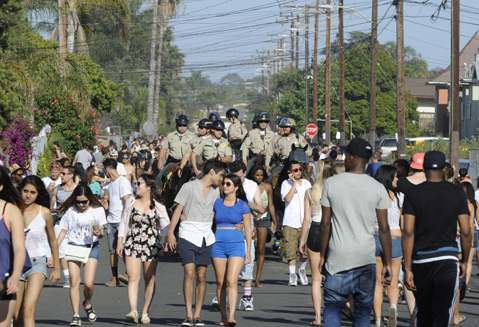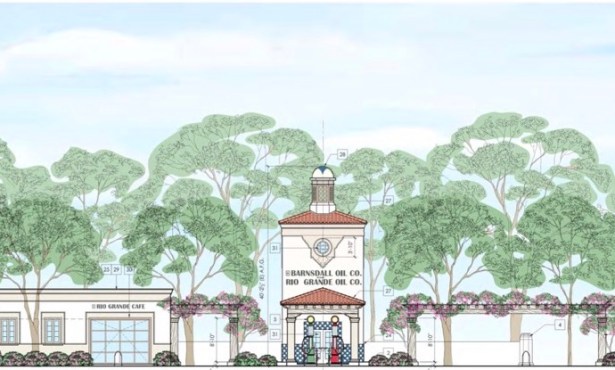Taming the Isla Vista Beast
Community Service District Idea Overreaches, LAFCO Cries

Just before Isla Vistans took to the streets to celebrate Deltopia, the latest legislative effort to establish a governing mechanism in Isla Vista received another unforgiving review from Santa Barbara’s Local Agency Formation Commission (LAFCO), a board of seven city, county, and special district representatives.
Last week’s meeting echoed previous ones, as commissioners voiced qualms about Assemblymember Das Williams’s bill, AB 3, which seeks to establish a community service district (CSD) in the unincorporated college town. The LAFCO board voted 6-1 to oppose the bill unless it’s amended.
Commissioners’ biggest beef with AB 3 is that it would bypass their agency, which was set up decades ago by the state to implement special districts. And those special districts, they argued, do not contain the array of services outlined in this bill, such as a tenant mediation program, planning commission, parking district, police officers, and graffiti abatement.
The bill, commissioners emphasized, also fails to spell out key details; for instance, is a special district even financially feasible? To study the money, a host of organizations — a private donor, Fund for Santa Barbara, UCSB Foundation, and Associated Students (AS) — are expected to contribute to a $70,000 analysis by Economic & Planning Systems, the firm that completed one for Goleta’s cityhood in 2001.
It remains to be seen how much sway LAFCO’s formal opposition will have in the State Legislature. State Senator Hannah-Beth Jackson, who has worked in unison with Williams on gun-control legislation following the Isla Vista shootings and on efforts to address sexual assaults on community college campuses, said the bill had a number of aspects — boundaries, board makeup, and the feasibility study — that are important to determine before she takes a position. “Generally speaking, I support self-governance,” Jackson said. “With its history, [Isla Vista] is a stepchild. Nobody wants responsibility for it. The area has been crying out for some type of recognition for decades.”
Jackson lauded the public process set up by Williams’s office; one or two community meetings have taken place weekly over the past four months. At them, the details have been deliberated — special district boundaries, governing body size and makeup (elected or appointed), types of taxes, and provided services. Some CSD skeptics who attended regularly have petered off, but Williams said momentum for the CSD has grown since the process began.
Another crucial question remains on incorporating UCSB into district boundaries. AB 3 supporters think doing so could potentially oblige the university financially in exchange for an appointed board seat. But such an arrangement, claim others, could give the university — which has historically turned a blind eye to the town — too much say. On Thursday, a few LAFCO commissioners called on UCSB to formally partake in AB 3 discussions.
For its part, the university foundation’s Board of Trustees funded an extensive study of I.V. last summer and drafted 20 pages of recommendations. Topping the list was the establishment of a CSD. Since then, a chancellor’s committee has met regularly to gather information on I.V. issues.
As written, the legislation retains I.V.’s Recreation and Park District, which generates about $1.36 million annually from a mix of property taxes and a special tax based on number of bedrooms. Should the bill be signed into law, taxes to support the CSD must be approved by two-thirds of residents. Currently, a Utility Users Tax, a sales tax, or a Transient Occupancy Tax are all on the table. LAFCO executive director Paul Hood called the sales-tax option unprecedented as it is typically reserved for cities or counties.
Attempts at cityhood for Isla Vista failed three times in the ’70s and ’80s, and advocates blame LAFCO for blocking those efforts. In 1972, a state bill for the creation of an Isla Vista College Community Services District was signed into law, but the special district never formed. At the time, it lacked popular support because organizers favored cityhood, according to longtime housing advocate Frank Thompson, who arrived in I.V. in 1974 as a 17-year-old UCSB student. “In 1973, the community was totally in love with being a city,” Thompson said. Hot-button issues then were rent control and police towers, he added.
That Isla Vista’s student population only stays for a few years is often noted as a hindrance to change. Many students engaged in AB 3 are not seniors, noted Cameron Schunk, attending the talks as AS Local Affairs external vice president. Schunk graduates in June, but he plans to stay for some time as he has put a whole lot of “blood, sweat, and tears into this process,” he said. “While individual [students] will come and go, the student population will stay for decades.”


